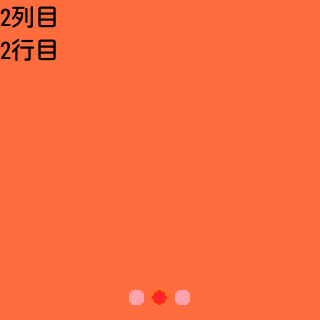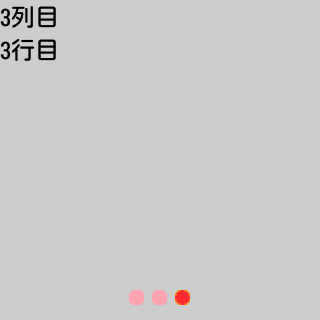Android WearのGridViewPagerで個別レイアウトのページにインジケータを表示させます。
【準備】
1.「Extrasライブラリ(Android Support Library v20等)のアップデート」の手順で、「Android Support Library」をv20に更新しておきます。
2.「wearable 1.0.0のライブラリプロジェクトの作成方法」の手順で、「wearable 1.0.0」のライブラリプロジェクトを作成しておきます。
※ADT23.0.2ではAndroid Wearに対応していない為の、暫定処置です。
※実機でデバッグする場合には以下を実行しておきます。
「Sumsung Gear LiveのADBドライバのインストール方法」の手順で、ADBドライバをインストールしておきます。
【手順1】
1.「Androidプロジェクトの作成・実行方法(バージョン別一覧)」のAndroidプロジェクトの作成手順で、「AndroidWearSample14-003-GridViewPagerIndicator」といプロジェクトを作成。
※プロジェクトの設定は以下の通り。
※他の項目は任意。
| 項目名 | 項目に設定する値 |
| アプリケーション名(Application Name) | com.example.androidwearsample14_003 |
| プロジェクト名(Project Name) | AndroidWearSample14-003-GridViewPagerIndicator |
| パッケージ名(Package Name) | com.example.androidwearsample14_003 |
| Build SDK | API 20 |
| Minimum Required SDK | API 20 |
2.「wearable 1.0.0プロジェクトをライブラリに指定する方法」の手順で、wearable 1.0.0をライブラリ設定しておきます。
3.「android-support-v13.jarをライブラリに設定する方法」の手順で、android-support-v13.jarをライブラリ設定しておきます。
【手順2】
1.「AndroidManifest.xml」は以下の通り。
<manifest xmlns:android="http://schemas.android.com/apk/res/android"
package="com.example.androidwearsample14_003"
android:versionCode="1"
android:versionName="1.0" >
<uses-sdk
android:minSdkVersion="20"
android:targetSdkVersion="20" />
<application
android:allowBackup="true"
android:icon="@drawable/ic_launcher"
android:theme="@android:style/Theme.DeviceDefault.Light" >
<activity android:name="com.example.androidwearsample14_003.MainActivity" >
<intent-filter>
<action android:name="android.intent.action.MAIN" />
<category android:name="android.intent.category.LAUNCHER" />
</intent-filter>
</activity>
</application>
</manifest>
2.「Ctrl+Shift+F」を押し、コードをフォーマッティング。3.「Ctrl+S」を押し、ファイルを保存。
【手順3】
1.「res/layout/activity_main.xml」は以下の通り。
<RelativeLayout xmlns:android="http://schemas.android.com/apk/res/android"
android:layout_width="match_parent"
android:layout_height="match_parent"
android:background="@color/white" >
<android.support.wearable.view.GridViewPager
android:id="@+id/fragment_container"
android:layout_width="match_parent"
android:layout_height="match_parent" />
<LinearLayout
android:layout_width="wrap_content"
android:layout_height="wrap_content"
android:layout_alignParentBottom="true"
android:layout_centerHorizontal="true"
android:layout_marginBottom="10dp" >
<ImageView
android:id="@+id/indicator1"
android:layout_width="wrap_content"
android:layout_height="wrap_content"
android:layout_marginRight="5dp"
android:src="@drawable/full" />
<ImageView
android:id="@+id/indicator2"
android:layout_width="wrap_content"
android:layout_height="wrap_content"
android:layout_marginRight="5dp"
android:src="@drawable/empty" />
<ImageView
android:id="@+id/indicator3"
android:layout_width="wrap_content"
android:layout_height="wrap_content"
android:src="@drawable/empty" />
</LinearLayout>
</RelativeLayout>
2.「Ctrl+Shift+F」を押し、コードをフォーマッティング。3.「Ctrl+S」を押し、ファイルを保存。
【手順4】
1.「任意のファイルの作成方法」の手順で「res/layout/fragment_column1.xml」を作成。
2.「res/layout/fragment_column1.xml」は以下の通り。
<LinearLayout xmlns:android="http://schemas.android.com/apk/res/android"
android:layout_width="match_parent"
android:layout_height="match_parent"
android:background="@color/white"
android:orientation="vertical" >
<TextView
android:layout_width="fill_parent"
android:layout_height="wrap_content"
android:text="1列目" />
<TextView
android:id="@+id/text"
android:layout_width="fill_parent"
android:layout_height="wrap_content" />
</LinearLayout>
3.「Ctrl+Shift+F」を押し、コードをフォーマッティング。4.「Ctrl+S」を押し、ファイルを保存。
【手順5】
1.「任意のファイルの作成方法」の手順で「res/layout/fragment_column2.xml」を作成。
2.「res/layout/fragment_column2.xml」は以下の通り。
<LinearLayout xmlns:android="http://schemas.android.com/apk/res/android"
android:layout_width="match_parent"
android:layout_height="match_parent"
android:background="@color/orange"
android:orientation="vertical" >
<TextView
android:layout_width="fill_parent"
android:layout_height="wrap_content"
android:text="2列目" />
<TextView
android:id="@+id/text"
android:layout_width="fill_parent"
android:layout_height="wrap_content" />
</LinearLayout>
3.「Ctrl+Shift+F」を押し、コードをフォーマッティング。4.「Ctrl+S」を押し、ファイルを保存。
【手順6】
1.「任意のファイルの作成方法」の手順で「res/layout/fragment_column3.xml」を作成。
2.「res/layout/fragment_column3.xml」は以下の通り。
<LinearLayout xmlns:android="http://schemas.android.com/apk/res/android"
android:layout_width="match_parent"
android:layout_height="match_parent"
android:background="@color/light_grey"
android:orientation="vertical" >
<TextView
android:layout_width="fill_parent"
android:layout_height="wrap_content"
android:text="3列目" />
<TextView
android:id="@+id/text"
android:layout_width="fill_parent"
android:layout_height="wrap_content" />
</LinearLayout>
3.「Ctrl+Shift+F」を押し、コードをフォーマッティング。4.「Ctrl+S」を押し、ファイルを保存。
【手順7】
1.「任意のディレクトリの作成方法」の手順で「res/drawable」ディレクトリを作成。
2.以下の画像を「empty.png」という名前で保存。
3.以下の画像を「full.png」という名前で保存。
【手順8】
1.「src/com/example/androidwearsample14_003/MainActivity.java」は以下の通り。
package com.example.androidwearsample14_003;
import android.app.Activity;
import android.app.Fragment;
import android.app.FragmentManager;
import android.os.Bundle;
import android.support.wearable.view.FragmentGridPagerAdapter;
import android.support.wearable.view.GridViewPager;
import android.widget.ImageView;
import com.example.androidwearsample14_003.R;
public class MainActivity extends Activity {
private static final int NUMBER_ROW = 3;
private static final int NUMBER_COL = 3;
private MainAdapter mainAdapter;
private GridViewPager gridViewPager;
private ImageView indicator1;
private ImageView indicator2;
private ImageView indicator3;
@Override
protected void onCreate(Bundle savedInstanceState) {
super.onCreate(savedInstanceState);
setContentView(R.layout.activity_main);
gridViewPager = (GridViewPager) findViewById(R.id.fragment_container);
indicator1 = (ImageView) findViewById(R.id.indicator1);
indicator2 = (ImageView) findViewById(R.id.indicator2);
indicator3 = (ImageView) findViewById(R.id.indicator3);
gridViewPager.setOnPageChangeListener(new GridViewPager.OnPageChangeListener() {
@Override
public void onPageScrollStateChanged(int i) {
}
@Override
public void onPageScrolled(int i, int j, float f, float f1, int k, int l) {
}
@Override
public void onPageSelected(int i, int j) {
setIndicator(j + 1);
}
});
mainAdapter = new MainAdapter(getFragmentManager());
gridViewPager.setAdapter(mainAdapter);
}
private void setIndicator(int i) {
switch (i) {
case 1:
indicator1.setImageResource(R.drawable.full);
indicator2.setImageResource(R.drawable.empty);
indicator3.setImageResource(R.drawable.empty);
break;
case 2:
indicator1.setImageResource(R.drawable.empty);
indicator2.setImageResource(R.drawable.full);
indicator3.setImageResource(R.drawable.empty);
break;
case 3:
indicator1.setImageResource(R.drawable.empty);
indicator2.setImageResource(R.drawable.empty);
indicator3.setImageResource(R.drawable.full);
break;
default:
break;
}
}
private static class MainAdapter extends FragmentGridPagerAdapter {
public MainAdapter(FragmentManager fragmentManager) {
super(fragmentManager);
}
@Override
public int getRowCount() {
return NUMBER_ROW;
}
@Override
public int getColumnCount(int row) {
return NUMBER_COL;
}
@Override
public Fragment getFragment(int row, int column) {
if (column == 0) {
return new Column1Fragment(row);
} else if (column == 1) {
return new Column2Fragment(row);
} else {
return new Column3Fragment(row);
}
}
}
}
2.「Ctrl+Shift+F」を押し、コードをフォーマッティング。3.「Ctrl+S」を押し、ファイルを保存。
【手順8】
1.「任意のファイルの作成方法」の手順で「src/com/example/androidwearsample14_003/Column1Fragment.java」を作成。
2.「src/com/example/androidwearsample14_003/Column1Fragment.java」は以下の通り。
package com.example.androidwearsample14_003;
import android.app.Fragment;
import android.os.Bundle;
import android.view.LayoutInflater;
import android.view.View;
import android.view.ViewGroup;
import android.widget.TextView;
public class Column1Fragment extends Fragment {
private int row;
public Column1Fragment(int row) {
this.row = row;
}
@Override
public View onCreateView(LayoutInflater inflater, ViewGroup container, Bundle savedInstanceState) {
View view = inflater.inflate(R.layout.fragment_column1, container, false);
((TextView) view.findViewById(R.id.text)).setText((row + 1) + "行目");
return view;
}
}
3.「Ctrl+Shift+F」を押し、コードをフォーマッティング。4.「Ctrl+S」を押し、ファイルを保存。
【手順9】
1.「任意のファイルの作成方法」の手順で「src/com/example/androidwearsample14_003/Column2Fragment.java」を作成。
2.「src/com/example/androidwearsample14_003/Column2Fragment.java」は以下の通り。
package com.example.androidwearsample14_003;
import android.app.Fragment;
import android.os.Bundle;
import android.view.LayoutInflater;
import android.view.View;
import android.view.ViewGroup;
import android.widget.TextView;
public class Column2Fragment extends Fragment {
private int row;
public Column2Fragment(int row) {
this.row = row;
}
@Override
public View onCreateView(LayoutInflater inflater, ViewGroup container, Bundle savedInstanceState) {
View view = inflater.inflate(R.layout.fragment_column2, container, false);
((TextView) view.findViewById(R.id.text)).setText((row + 1) + "行目");
return view;
}
}
3.「Ctrl+Shift+F」を押し、コードをフォーマッティング。4.「Ctrl+S」を押し、ファイルを保存。
【手順10】
1.「任意のファイルの作成方法」の手順で「src/com/example/androidwearsample14_003/Column3Fragment.java」を作成。
2.「src/com/example/androidwearsample14_003/Column3Fragment.java」は以下の通り。
package com.example.androidwearsample14_003;
import android.app.Fragment;
import android.os.Bundle;
import android.view.LayoutInflater;
import android.view.View;
import android.view.ViewGroup;
import android.widget.TextView;
import com.example.androidwearsample14_003.R;
public class Column3Fragment extends Fragment {
private int row;
public Column3Fragment(int row) {
this.row = row;
}
@Override
public View onCreateView(LayoutInflater inflater, ViewGroup container, Bundle savedInstanceState) {
View view = inflater.inflate(R.layout.fragment_column3, container, false);
((TextView) view.findViewById(R.id.text)).setText((row + 1) + "行目");
return view;
}
}
3.「Ctrl+Shift+F」を押し、コードをフォーマッティング。4.「Ctrl+S」を押し、ファイルを保存。
【手順11】
1.「Androidプロジェクトの作成・実行方法(バージョン別一覧)」のAndroidプロジェクトの実行手順で、実行。
※Android Wearの実機で動かす場合は、実機とPCをUSBで接続する。
【手順12】
1.Sumsung Gear Live(Android Wear)の場合、以下の様に表示されます。
以上です。





0 件のコメント:
コメントを投稿
注: コメントを投稿できるのは、このブログのメンバーだけです。